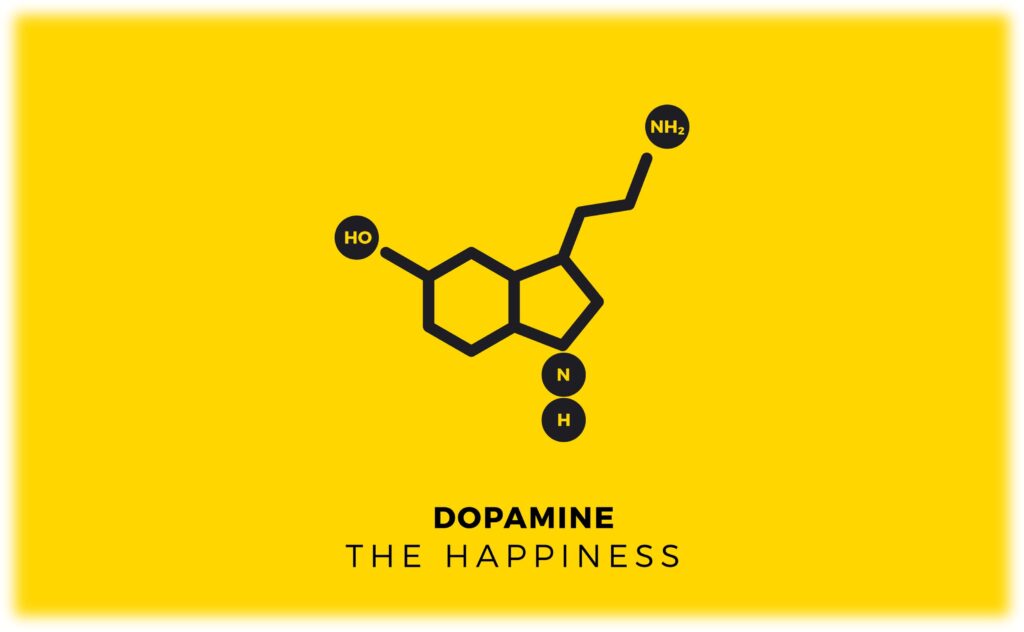
Dopamine – technically the only thing you enjoy.
The study of Dopamine came into prominence in the mid 1900’s, and its discovery formed a seminal event as a precursor to modern neuroscience. Dopamine is a neurotransmitter used to transmit messages along nerve cells. It’s role in cognitive functionality encompasses aspects from sleep and attention to motivation and learning. Often referred to as the feel-good hormone, the release of this chemical within the brain results in feelings of pleasure and happiness.
A happy drug in its own right, Dopamine is an inotropic agent which means it has the ability to change contractions of the heart. A fitting fact, considering the role it plays in emotions. Dopamine is the single most integral currency in how we perceive and experience the world.
The way in which Dopamine is regulated within the body impacts our levels of pleasure and pain. Dopamine is the primary driver behind human survival. Long before the “Just-Eat” app, our early ancestors would have to scour the lands for sustenance. Often encountering dangers to life, survival was all that mattered. The release of this chemical allowed for greater attention and focus when applied to hunting and foraging. Today, a life lived on wants not needs is the new norm.
Let’s take a deeper dive into how Dopamine actually works. Now, I’m a bad swimmer in that I can’t swim. Apparently according to my Wife (who was a lifeguard – I chose wisely!), walking along the floor of a swimming pool whilst making motions of swimming with my arms doesn’t count as swimming.
So, I’ll need a helping hand from you kind folk to articulate this next bit.
Connections formed by neurons along a pathway is called a neuropathway (simple enough but a discretionary warning of a steep curve ahead). There are three Dopamine neuropathways. Each pathway is a system. The first system is traced within the substania nigra pars compacta (SNpc) located in the middle of the brain. This area of the brain is involved in the planning, control and execution of voluntary movements. This motor behaviour is influenced by the first Dopamine system. The second Dopamine system also sits within the mid-brain region, and is found within the ventral tegmental area. This second system can be broken down into two sub-systems. The first sub-system influences motivational behaviour. The second sub-system influences cognitive behaviour. The third Dopamine system is found within the base of the brain, and is involved in the proper functioning of the body. Each system has a feedback loop. These dopamine-driven feedback loops work as a never-ending cycle fed by the relationship between how neurotransmitters work with the reward system of the brain.
Cast your minds back to when you last ate chocolate. With every bite, a tiny rush of pleasure followed. This sensation drove the urge for a second bite, and third and fourth. Maybe even the urge to reach for another bar entirely (don’t worry, no judgement here). This is your dopamine-driven feedback loop in full flow. Now unfortunately for us chocolate lovers, Dopamine doesn’t cause the feeling of pleasure from chocolate (so we can’t blame it), however it does reinforce the effects of consuming chocolate.
To put this in perspective, when cocaine is consumed, a person’s base Dopamine level is raised by 10 times. To continue feeding this rush of immense pleasure, cocaine users will continue to chase the initial high. But over time, the perceived pleasure becomes less, as the brain begins to acclimatise to its new dopamine norm, which is substantially higher than its base level. A prolonged state of a “high” triggers addiction. The reward pathway is in full drive. Not controlling this reward pathway is detrimental to overall health and wellbeing. The necessity to understand how to better utilise Dopamine release within our daily lives has a profound effect on our happiness.
Instant gratification is prevalent within today’s societies. Food, relationships, money. Almost everything that was once a motivational challenge has now become an expected outcome. The compounded effects of instant gratification has led to a perpetual loop of self-indulgence. Rather than viewing healthy relationships, wealth and security as goals to strive towards on the journey of life, they’re seen as expectations that come with a “when”, not “if”. This gross-misrepresentation has distorted what perceived reality is, because of an in-balance of Dopamine levels.
I’ve scrolled through Youtube aimlessly for hours, knowing it doesn’t feel great, but doing it anyway. This is actually the addiction of the brain to Dopamine hits that is prodding me to continue with this unproductive activity. Ever binged on a whole multi-pack of crisps (knowing that 1 pack would have sufficed)? Failure to break the Dopamine fuelled self-indulgence loop leads to feelings of laziness and lack of motivation to be productive. The most effective way (trialled and tested) to recalibrate Dopamine levels is to stop over-indulging in any activity that is self-Dopamine inducing, such as video games, social media, junk food. Instead, engage in productive activities such as reading, exercise and meditation.
Over time Dopamine levels will level out, which will increase focus, attention and motivation.
I once remember asking my Uncle why people were satisfied with being content, when surely happiness was worth the effort. It was a question that unveiled my naïve youth. His response to me was that reaching a level of contentedness was a form of happiness in itself.
These wise words were lost on inexperienced ears. But now I understand. I echo that life is a journey, not a destination. Business tycoon Steven Bartlett, on his podcast A Diary of a CEO (subscribe!), once shared that becoming a millionaire left him on the brink of depression. So many high achievers reverberate a similar tone. Goals and milestones in life are there as a form of inspiration.
We sell ourselves the dream of attaining happiness upon their achievement. Yet what follows is more often than not a feeling of emptiness, as we’re left holding a bag labelled “what now?”. Dopamine is released when we anticipate and receive a reward. Rewards are subjective to the individual. I am a fellow coffee lover. My morning cuppa as a pick-me-up is an intrinsic reward. Caffeine increases dopamine levels. So do things such as chocolate (no dark for me thanks) exercise, and money.
We all have a primitive underlying level of Dopamine.
Peaks and troughs are interlinked with feelings of pleasure and pain. We fluctuate above and below our base level, and usually return to this naturally. The higher the peak or lower the trough, the more time it takes to return to base. What Steven Bartlett experienced was a high release of Dopamine (at the point of becoming a millionaire), followed by a steep trough (low levels of Dopamine below base) which resulted on the fringe of depression. Science has proven that finding pleasure in the pursuit of a goal as opposed to associating pleasure to the achievement of the goal, aggregates the levels of Dopamine release. This approach protects from steep troughs and elongates pleasure over a greater time span.
I’ve consciously made the effort to tune my mind into the present moment, whenever I am trying to achieve a goal. I’ve not exerted any efforts to exercise for the past several years.
So, I set myself a target to run a 5K without stopping.
The way I regulated my Dopamine levels for motivational enhancement was to keep a log of my running performance (measuring speed, distance and calories). I set myself an achievable aim for 3 days a week on the treadmill. My only goal was to run that 5K. I began to ground myself in the present moment whilst walking to the gym. I would take time to enjoy the fresh air, the light breeze, the gentle stroll, the thought of listening to my favourite music on route. When I got back from my run, I would welcome the comfortable notion of enjoying a long hot shower, of changing into my PJs knowing my day had been a success.
By allowing myself to melt into the present, whilst challenging myself to achieve my goal, my body was benefitting from a steady increase of Dopamine throughout the day to keep me motivated. And yes, I did end up running that 5K, and then a 10K, and then a 15K.
Finding pleasure in the pursuit of a goal allowed me to exceed the goal in a matter of weeks, and when I reached my desired target, the continuous release of Dopamine (by grounding myself in the present) spurred me on to continue running.
